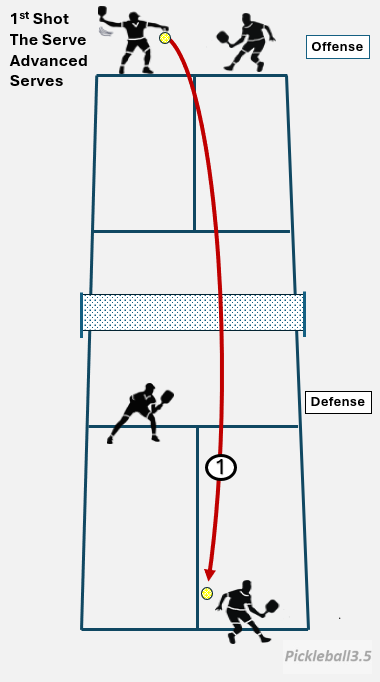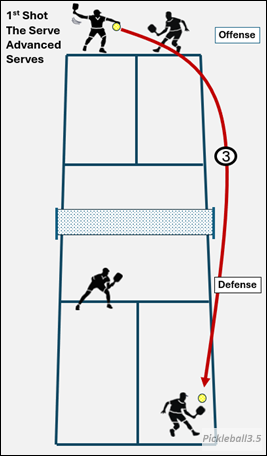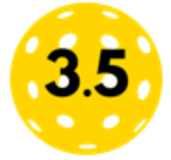
This Pickleball 3.5 Blog Quick Reference Guide features court illustrations and concise summaries of strategy posts focused on the pickleball serve. It is designed to help you navigate the blog visually, with posts arranged from simple to more advanced topics. Scroll down to explore post summaries in order, or use the menu below to jump directly to a topic of interest.
Quick Navigation
2.0-3.0 Skill Level
Serve Overview and Player Positions
The illustration below shows player setup at the start of a point.

Offensive Player A serves from behind the baseline to Player D into their service court. The serve can hit any of the lines in the service court except the kitchen line. The kitchen line is considered to be in the kitchen and the serve cannot land in the kitchen.
The serve may seem straightforward, but its nuances can be critical in setting up the return of serve, third shot and dinking, which are often where the point is decided.
Read the full post on The Serve Overview and Player Positions.
Serve Consistency and Control
This illustration shows a serve hit into the net and one out of bounds. These are mistakes you can’t afford to make!

The serve in pickleball sets the tone for the rally. While many players see the serve as an opportunity to score, experienced players know that the true goal is to get the ball in play consistently and strategically.
Master the Basics First: Avoid using fancy spins or excessive power early on. Instead, work on a simple, consistent serve that lands deep in the opponent’s court. A steady stroke is more effective than trying to overwhelm your opponent.
Read the full post on Serve Consistency and Control.
Pickleball Serve Options
Illustration of a pickleball player hitting a drop serve.

You have 2 serve options in pickleball, the volley and drop serve.
In pickleball, the serve is your first opportunity to set the tone for the point.
Understanding the different types of serves can significantly enhance your game. If you’re new to the game, this post will help you build a solid foundation.
You may use the volley serve but understanding the pickleball drop serve and its usage as an option is important.
Read the full post on Pickleball Serve Options.
Pickleball Serve Legality Disputes
An AI image of 2 players discussing serve legality.

In Pickleball serve legality disputes are inevitable. If you use the traditional volley serve in pickleball, you might face an opponent who claims your serve isn’t legal.
If you’re questioning whether your serve is legal, practice a drop serve as an alternative.
The drop serve doesn’t have the same restrictions as the traditional serve. You simply drop the ball and hit it after it bounces, making it a simpler, legal option if your serve is challenged.
If you are challenged during a game, switching to a drop serve can avoid more disputes and keep the game moving.
Read the full post on Handling Serve Legality Disputes.
Serving Under Pressure
AI image of a pickleball player feeling pressure when they are about to serve.

Serving under pressure in Pickleball is a common situation as close games can add pressure to all aspects of your game as you strive to do your best and win.
If you are struggling with your serve, you are not alone. Whether you’re a beginner or a 3.5+ player, it happens. The key is to take a breath and slow things down.
Serving under pressure is about staying composed, relaxing and focusing on the serve. With practice and a good routine, you’ll feel confident in crucial moments.
Read the full post on Serving Under Pressure.
Serve Player Positioning Mistake
In this illustration, the server’s partner (Player B) moves onto the court after the serve and the return of serve is hit hard and deep right at them.

It may seem like a minor thing, but some beginner players have a habit of moving onto the court after the serve, before the return shot is even hit.
Maintain good court positioning during the pickleball serve. Don’t move onto the court after the serve. Hold your position in case the return of serve is deep and move forward quickly to play a short return of serve.
Read the full post on Serve Player Positioning.
Defensive Player Mistakes
This illustration shows the defensive player (Player C) back away from the kitchen line and out of position at the start of a point. Player D is on the court and out of position to handle the serve.

Defending against the serve and preparing for the third shot involves using effective court positioning.
Always position yourself at the kitchen line at the start of the point and don’t give up an inch.
When waiting for the serve, maintain your position behind the baseline.
Read the full post on Defnsive Player Positioning Mistakes.
Stacking in Pickleball
Humorous AI image of players stacking in pickleball.

Stacking in pickleball is an advanced court positioning strategy where players change positions at the start of a point. It ensures that a player with their forehand is always positioned in the middle of the court, maximizing offensive and defensive opportunities.
Stacking on the serve can be done by the Offensive players, Defensive players or both.
Mastering stacking in pickleball is a game-changer, helping you and your partner maintain optimal positioning and gain a competitive edge.
Read the full post on Stacking in Pickleball.
Offensive Serve Stacking
The illustration below shows a right-handed and left-handed player setting up for a serve without stacking. After the serve they will have no forehand in the middle to play the third shot.
To stack, player B shifts over behind the server. After the serve, player A moves over to where Player B was. Now there is a forehand in the middle to play the third shot.

Serve stacking in pickleball is an offensive strategy designed to position a player with their forehand in the center of the court after the serve. This ensures the strongest possible response to the third shot after the serve is returned, giving your team an advantage against advanced opponents.
To improve your game, always use serve stacking when playing with a right-handed and left-handed partner.
Read the full post on Offensive Serve Stacking.
Defensive Stacking
In the illustration below, the defensive players are right-handed and left-handed. Without stacking there is no forehand in the middle to defend against the third shot.
To stack, player C moves to the opposite side to stack on the serve return. After returning the serve, player D moves to where Player C was at the kitchen line. Now the defense has a forehand in the middle to defend against the third shot from the offense.

Defensive stacking in pickleball is a strategic approach on the return of serve that positions a player with their forehand in the center of the court. This setup helps defend against the offensive third shot, neutralizing your opponents’ advantage and giving you better court coverage.
To reach higher levels of play, understanding and practicing both offensive and defensive stacking is essential. Try it in casual games to build confidence and use it strategically to gain an edge against advanced opponents.
Read the full post on Defensive Stacking.
Advanced Serve-Target the Backhand
The illustration below shows a pickleball serve targeting the backhand of the serve returner.

A pickleball serve that targets your opponent’s backhand is effective, but it requires practice to master.
A backhand return is always a tougher shot to execute effectively, so if you can occasionally force one, you’ve hit a good serve.
Read the full post on Advanced Serves.
Advanced Serve-Use Spin
This illustration shows a pickleball serve with left to right spin.

Adding even a small amount of spin to your serve can complicate your opponent’s return.
Good players will almost always return it, but the goal is simply to make their return more challenging.
Read the full post on Advanced Serves.
Advanced Serve-The Lob Serve
The illustration below shows a pickleball lob serve.

The Lob serve involves striking the ball high and deep and, of course, the returner has to let it bounce so it is more challenging for them to hit a powerful drive.
A drive serve can be countered with minimal effort due to its inherent speed. The ball is moving fast and will come off your paddle fast because of this.
However, with a lob serve, since the ball is not advancing forward as much as it is bouncing upward, the returner must exert more force to send it back, which complicates their return.
Read the full post on Advanced Serves.



This is a great quick reference guide. Thank you for your efforts on the blog. Very helpful.